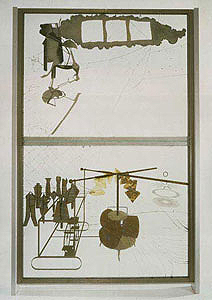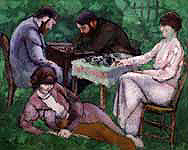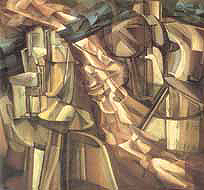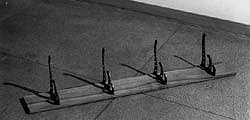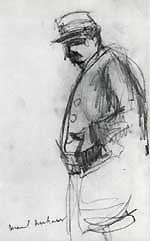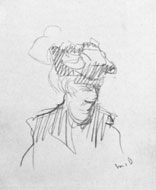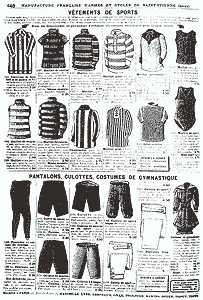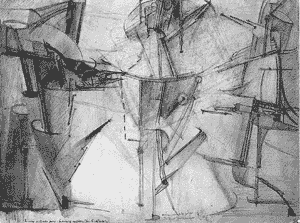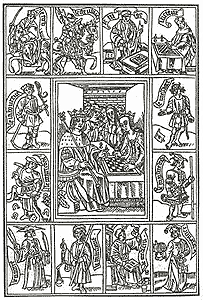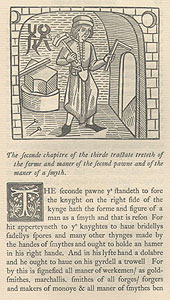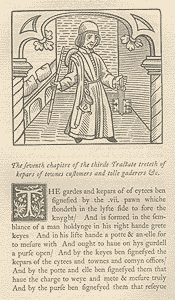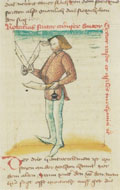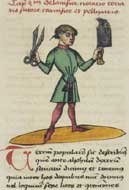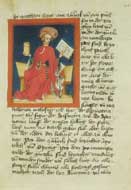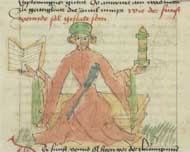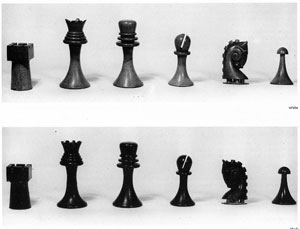|
The Bachelors: Pawns in Duchamp's Great Game by Bradley Bailey |
|||||||||||||||||||||||||||||||||||||||||||||||||||||||||||||||||||||||||||||||||||||||||||||||||||||||||||||||
|
Many metaphors borrowed from chess have taken their place in the vocabulary of everyday life…. Perhaps the commonest in modern usage is to represent diplomatists, politicians or anybody who is pursuing a large plan without revealing his ultimate intentions, as engaged in a game in which the Pawns are the innocent tools with which the plan is carried through (Murray, History 537).
Marcel Duchamp's
obsession with chess, for which he professed to "quit" making art in
the early 1920s, has been meticulously documented by critics and historians.
Virtually all of the principal studies of Duchamp's career make reference
to his lifelong association with the game, from his early drawings and
paintings to his pursuit of the French Chess Championship. However,
despite the abundance of literature concerning Duchamp's many chess-related
activities, scholars have, for the most part, neglected to regard the
history of the game as a potential resource for imagery in Duchamp's
work. One segment of the history of chess, the evolution and symbolism
of the individual chess pieces, may have been particularly appealing
to Duchamp. In fact, one of the chief elements of Duchamp's monumental
The Bride Stripped Bare by Her Bachelors, Even or The Large
Glass of 1915-23 (Fig. 1), namely the Nine Malic Molds,
appears to have been derived from chess-piece history.
It is perhaps prophetic that, at the age of thirteen, Duchamp was taught both painting and chess in the same year (Schwarz 1:64). A 1904 etching by Jacques Villon of a seventeen-year-old Duchamp embroiled in a match with his sister Suzanne (Fig. 2) testifies to his continued interest in the game. Three of Duchamp's major works during the years 1910-11, The Chess Game, The Chess Players, and Portrait of Chess Players (Figs. 3-5), not only indicate the pervasiveness of the game in his life and art, but also foreshadow the complex strategies he would use both in his art and in his often antagonistic relationship with art world officials. While Robert Lebel stated in his influential biography of Duchamp that "chess seems to have had less place in his life from 1912 to 1922" (48), a brief survey of those years shows that Lebel's assessment is clearly not the case. In 1912, shortly before he ceased working in traditional media, Duchamp executed a number of studies and an oil based on the theme of, according to Arturo Schwarz, "a mythical king and queen of chess" (1:64). This king and queen, a motif that Duchamp explicitly stated was derived from chess (D'Harnoncourt and McShine 260), formed the
By 1918, Duchamp was living in Buenos Aires and, in addition to being in the midst of the preparations for the Glass, devoting more and more time to chess. "I have thrown myself into the game of chess," Duchamp said in 1919 (qtd. in Naumann 12), and, upon moving to New York in 1920, became a member of the Marshall Chess Club. Between 1923 and 1925, he played in several competitive chess tournaments against some of the finest players in the world, and surprised many by winning the Chess Championship of Haute Normandie in 1924 (Keene 125). He was pronounced a Chess Master by the French Chess Federation in 1925, the same year in which he designed the poster for the French Chess Championship in Nice (Fig. 8). While this short survey of chess in Duchamp's life and art covers only twenty-five years of a long and distinguished career and leaves out many interesting and interrelated activities in both fields, it is clear that his contributions to both pursuits did not go unrecognized. His achievements are commemorated by his inclusion in The Oxford Companion to Chess, in which he is named "the most highly esteemed artist to play chess at master level" (Hooper and Whyld 116). With this in mind,
it would be difficult to argue that chess did not in some way play a
role in the formation of the largest and most complex project of Duchamp's
early career, The Large Glass. Affinities between the Glass and
chess have been previously noted, such as Yves Arman's observation that
Duchamp "arranged all the elements of the bride on one side, and all
the elements of the bachelors on the other, and one can easily consider
that their relative position or intended interaction have a lot to do
with a game of chess" (19). While it would be futile to attempt to summarize
the various aspects of the Glass, which consists of equal parts
engineering, chemistry, physics, chance, humor and fantasy, it is significant
to note that the Glass is both a sculpture and a mechanism, albeit
a mechanism of conceptual rather than mechanical intent. The individual
parts do not move; the mechanistic aspect of the Glass is entirely
up to the imagination of the viewer. This aspect of the Glass
corresponds strongly with comments Duchamp made about chess. In more
than one conversation he made reference to the plasticity of the chess
game, and described it to Laurence Gold as a "mechanistic sculpture"
(qtd. in Schwarz 1:72). Though the pieces in a chess game do
move, it is important to remember that the pieces are merely physical
markers for a contest that is principally mental. Indeed, many of the
great masters of chess played matches without ever looking at the board
during the game, a type of play called blindfold chess (Hooper and Whyld
45). Thus, as in chess, the components of the mechanism of the Glass
are not automatic, but require the visualization of the movement of
the mechanism in order to play out the scenario.
Duchamp began to show an interest in uniforms as early as 1904-05, when he executed numerous sketches of a variety of professions. Several of the occupations he depicted in these studies, including the reservist (presumably the antecedent of the gendarme), the policeman and the undertaker (Figs. 9-11), would reappear as molds in the Glass. It is clear from the majority of these sketches that Duchamp's primary goal was to record the principal details of the various costumes rather than the individuals themselves, since most of the figures have either roughly delineated or no facial features. Moreover, Duchamp sketched several of these individuals, such as the policeman, from behind, concealing their faces completely. By the time of their inclusion in the Glass, these uniforms would be divested of the bodies completely, since the individuals wearing the uniforms did not contribute to the understanding of the clothing as representative of its respective profession. It is significant at this point to note that all of these early sketches are of men, and that each of the vocations depicted is, according to Tomkins, "an occupation for which there is no female equivalent" (89).
One of the most significant developments in the social history of chess was the emergence of the chess moralities, which were allegorical sermons using the names and moves of the chessmen as the foundation for "ethical, moral, social, religious and political precepts" (Gizycki 23). Prior to the fifteenth century, several of the more conservative ecclesiastic establishments attempted to prohibit the playing of chess within the clergy, and these edicts often spread into the secular sphere as well. The Eastern Orthodox Church was especially zealous in its interdictions against chess, and members of the clergy known to indulge in the game were often castigated by those who abstained. One of the earliest documents containing a reference to chess to which an exact date can be assigned is a letter written by the eleventh-century Cardinal Petrus Damiani, Bishop of Ostia, who accused another bishop of "sporting away his evenings with the vanity of chess and so defiling with the pollution of a sacrilegious game the hand that offered up the body of the Lord" (Dennis and Wilkinson xx). On the whole, the Western Church was somewhat less impassioned about its proscriptions against chess, generally limiting its injunctions to the clergy and the knightly orders. Of the numerous decrees written in the twelfth, thirteenth and fourteenth centuries, perhaps the most well known is that of St. Bernard of Clairvaux, whose sanctions against the game for the Knights Templar were overturned in the fifteenth century (Murray, History 411). It is worthy of note that while chess was most explicitly forbidden within the clerical orders, the greater part of European chess literature from the Middle Ages was produced in churches and monasteries. The repudiation of chess by the church was not wholly unfounded for several reasons. As indicated in Damiani's diatribe, chess had strong associations with alea, an inclusive term used for all games of chance using dice, with or without a board (Murray, History 409). Indeed, a ninth-century variant of chess developed by the Muslims used dice, and written records suggest that this alternative format was popular in Europe during the twelfth and thirteenth centuries (Murray, History 410). The main attraction of involving dice in chess was that it sped up play; however, the introduction of chance into the game had an antipodal affect on the strategic element, and brought it dangerously close to gambling. In fact, the other aspect of chess that was most disturbing to the church was the regular involvement of stakes, which, for obvious reasons, was found intolerable. Despite the actions taken by the church, the spread of the game throughout Europe proved swift and unyielding, primarily due to its popularity with the aristocracy (Murray, History 428). In fact, according to Murray, "From the thirteenth to the fifteenth century, chess attained a popularity in Western Europe which has never been excelled, and probably never equaled at any later date" (History 428). As the popularity of the game grew beyond the restrictive power of the church, the friars wisely chose to adapt chess to ecclesiastical purposes by writing the chess moralities, after which the game's popularity rose to even greater heights. For the most part, the moralities were intended to provide moral instruction using the game as little more than a scaffold for religious precepts. The most famous of these moralities by far was written between 1275 and 1300 by the Dominican monk Jacobus de Cessolis, titled Liber de moribus Hominum et officiis Nobilum ac Popularium super ludo scacchorum (On the Customs of Men and Their Noble Actions with Reference to the Game of Chess). Arguably the most prominent book of its time, the number of existing manuscripts of Cessolis's sermon indicates that it must have rivaled the Bible in popularity (Murray, History 537). Written in Latin, the sermon was translated into virtually every European language, often using texts that were themselves several generations away from the original text, which accounts for the wide variations one encounters from version to version. The most well known of these translations is the famed English printer William Caxton's Game and Playe of the Chesse, which was published in Bruges in 1475, followed by a second illustrated edition printed in London in 1483. Caxton's version, one of the earliest books to be printed in English, is a translation of a French adaptation of Cessolis's manuscript written by the friar Jean de Vignay around the middle of the fourteenth century (Murray, History 547). As indicated in the following passage from Hans and Siegfried Wichmann's survey of the history of chess pieces, the individuated pawns served merely as vehicles for Cessolis's narrative:
The pawns, which stood for the commonality, were subdivided into eight vocations: laborers and farmers, smiths, weavers and notaries, merchants, physicians, innkeepers, city guards, and ribalds and gamblers (Murray, Short History 34). Each pawn is clearly recognizable by the attributes of its trade, as seen in an illustration from the cover of a fifteenth-century French book on chess (Fig. 21), which is conveniently labeled (and, remarkably, includes the player or l'acteur in the upper right-hand corner). The placement of each vocation on the board was crucial, since the pawn had to be associated with the role of the more significant piece behind it. For instance, the smiths and city guards, as seen in two woodcuts from Caxton's illustrated edition (Figs. 22 and 23), were placed in front of the knights because smiths were responsible for making bridles, saddles and spurs (Caxton 85), and the city guards received their military training from the knights as well (Caxton 139).
Regardless of the translation, the images of the various pawns are always similar because Cessolis included vivid descriptions of how each respective pawn was to be depicted. For example, the weaver and notary, as seen in an illustration from a German translation of 1456 (Fig. 24) and a depiction from a Latin transcription of 1460 (Fig. 25), "shall have a pair of scissors in his right hand and a knife in his left. At his belt shall be writing utensils and a pen behind his right ear" (Wichmann 34-35). These instructions were not always followed to the letter, however, as seen in an illustration of the physician from a 1407 German manuscript (Fig. 26), who holds the book in his left hand and the jar of medicine in his right rather than vice versa, as is correctly shown according to Cessolis's instructions in a 1454 German translation of either Bavarian or Austrian origin (Fig. 27). As with Duchamp's Cemetery of Uniforms and Liveries, Cessolis's strict guidelines for illustrating the various pawns indicate that the figures, or, more specifically, the bodies of the figures, were of less importance than the attributes of the pawn's respective profession. Moreover, like the molds, the pawns were always represented as male (as instructed by the text), and as a whole were meant to represent a specific class of people. While most of the professions of the allegorical pawns do not directly correspond with those of the molds, it makes sense that Duchamp would have updated the professions to better suit twentieth-century society.
If Duchamp's Malic Molds were indeed inspired by pawns from chess history, it may not be the first instance in which Duchamp personified chess pieces in his art. Dario Gamboni observed that in Duchamp's Portrait of Chess Players of 1911, the player on the left, a representation of Duchamp's brother Raymond Duchamp-Villon, holds in his hand a chess pawn with strikingly anthropomorphic characteristics (Gamboni). This can be interpreted as a play on the French word for pawn "pion," which also means "man" in reference to draughts or checkers, or the German "Bauer," which can denote "peasant" as well as a chess pawn. A crucial component of this study is identifying the sources through which Duchamp could have been introduced to the chess moralities, barring the possibility that he encountered them by word of mouth. One resource that has already been mentioned several times is Murray's A History of Chess, published by the Clarendon Press in 1913, which, incidentally, was the same year in which Duchamp executed his first plans for The Cemetery of Uniforms and Liveries. Described in The Oxford Companion to Chess as "perhaps the most important chess book in English" (Hooper and Whyld 265), Murray's 900-page History, the culmination of fourteen years of research, is an exhaustive exploration of the development of the game from its beginnings in the East to modern chess. Murray's massive undertaking included learning Arabic in order to consult essential manuscripts, and studying the major collections of chess artifacts and literature, most notably the collection of John Griswold White of Cleveland, Ohio, the largest chess library in the world. Considering Duchamp's already highly developed interest in chess at this time, it is conceivable that he would not only have known of Murray's valuable study, but perhaps consulted it as well. Pending conclusive evidence that Duchamp knew of Murray's History, there remains a significant resource of books in several languages on the history of chess and chess literature with which Duchamp may have been familiar. Murray's book was largely based on the work of the Dutch chess historian Antonius van der Linde, who published several books on the history of chess literature in Berlin at the end of the nineteenth century (Hooper and Whyld 219). In Paris, Librarie Hachette published Henry René d'Allemagne's Récréations et Passe-Temps in 1905, which also includes a description of the chess moralities. Supplementing this short list of secondary sources for Cessolis's sermon is the extensive number of primary sources, of which there are at least eighty versions of the Latin text alone (Murray, History 537), not to mention the profusion of existing French, English and German translations. Furthermore, an exact reprint of Caxton's Game and Playe of the Chesse, including the woodcut illustrations, was printed by Elliot Stock Publishers in London in 1883, which made a formerly rare text readily available to the public and, more importantly, Marcel Duchamp.
Work Cited
1. Ades, Dawn, Neil
Cox, and David Hopkins. Marcel Duchamp. London: Thames and Hudson,
1999. 2. Arman, Yves. Marcel
Duchamp Plays and Wins. New York: Galerie Yves Arman, 1984. 3. Cabanne, Pierre.
Dialogues with Marcel Duchamp. Trans. Ron Padgett. New York:
Da Capo, 1987. 4. Caxton, William.
Game and Playe of the Chesse. 1474. London: Elliot Stock, 1883. 5. D'Allemagne, Henry
René. Récréations et Passe-Temps. Paris: Librarie Hachette, 1905. 6. D'Harnoncourt,
Anne and Kynaston McShine, eds. Marcel Duchamp. New York: Museum
of Modern Art, 1973. 7. Dennis, Jessie McNab and Charles K. Wilkinson. Chess: East and West, Past and Present. Greenwich, Conn.: New York Graphic Society, 1968. 8. Gamboni, Dario. Lecture. Spring 1999. 9. Gizycki, Jerry. A History of Chess. English ed. B. H. Wood. London: Abbey Library, 1972. 10. Golding, John. Marcel Duchamp: The Bride Stripped Bare by Her Bachelors, Even. New York: Viking, 1972. 11. Henderson, Linda Dalrymple. Duchamp in Context: Science and Technology in the Large Glass and Related Works. Princeton, NJ: Princeton University Press, 1998. 12. Hopper, David and Kenneth Whyld. The Oxford Companion to Chess. New York: Oxford University Press, 1984. 13. Joselit, David. Infinite Regress: Marcel Duchamp (1910-1941). Cambridge, Mass.: MIT Press, 1998. 14. Keene, Raymond. "Principal Chess Happenings in the Life of Marcel Duchamp." Duchamp: Passim. Ed. Anthony Hill. St. Leonards, Australia: Gordon and Breach Arts International; Langhorne, Pa.: International Publishers Distributor, 1994, 125. 15. Lebel, Robert. Marcel Duchamp. Trans. George Hamilton. New York: Grove Press, 1959. 16. Murray, H. J. R. A History of Chess. Oxford: Clarendon Press, 1913. 17. ---. A Short History of Chess. Oxford: Clarendon Press, 1963. 18. Naumann, Francis M. "Affectueusement, Marcel: Ten Letters from Marcel Duchamp to Suzanne Duchamp and Jean Crotti." Archives of American Art Journal 29.4 (1982): 3-19. 19. Sanouillet, Michel. "Marcel Duchamp and the French Intellectual Tradition." Marcel Duchamp. Eds. Anne D'Harnoncourt and Kynaston McShine. 47-55. 20. Sanouillet, Michel and Elmer Peterson, eds. The Essential Writings of Marcel Duchamp. London: Thames and Hudson, 1973. 21. Schwarz, Arturo. The Complete Works of Marcel Duchamp. 3rd ed. 2 vols. New York: Delano Greenidge, 1997. 22. Steefel, Lawrence D., Jr. "Marcel Duchamp's Encore à cet Astre: A New Look." Art Journal, 36.1 (1976): 23-30. 23. Tomkins, Calvin. The World of Marcel Duchamp, 1887-1968. New York: Time-Life, 1974. 24. Wichmann, Hans and Siegfried. Chess: The Story of Chesspieces from Antiquity to Modern Times. Trans. Cornelia Brookfield and Claudia Rosoux. New York: Crown, 1964.
|
|||||||||||||||||||||||||||||||||||||||||||||||||||||||||||||||||||||||||||||||||||||||||||||||||||||||||||||||
